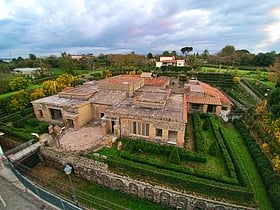Pompeii: Ruins
Places and attractions in the Ruins category
House of the Faun
Pompeii's largest house The House of the Faun, constructed in the 2nd century BCE during the Samnite period, was a grand Hellenistic palace that was framed by peristyle in Pompeii, Italy.
Temple of Jupiter
The Temple of Jupiter, Capitolium, or Temple of the Capitoline Triad, was a temple in Roman Pompeii, at the north end of its forum.
Suburban Baths
The Suburban Baths are a building in Pompeii, Italy, a town in the Italian region of Campania that was buried by the eruption of Mount Vesuvius in 79 AD, which consequently preserved it.
Temple of Apollo
Pompeii ruins of ancient Roman temples The Temple of Apollo is a Roman temple built in 120 BC and dedicated to the Greek and Roman god Apollo in the ancient Roman town of Pompeii, southern Italy. Located in the forum and facing the northern side of the town, it is the town's most important religious building and has ancient origins.
Villa of the Mysteries
The Villa of the Mysteries is a well-preserved suburban ancient Roman villa on the outskirts of Pompeii, southern Italy. It is famous for the series of exquisite frescos in one room, which are usually thought to show the initiation of a young woman into a Greco-Roman mystery cult.
Forum
The Baths of the Forum, also called the Baths of Fortune, are a thermal complex from Roman times, buried by the eruption of Vesuvius in 79 and found as a result of archaeological excavations in ancient Pompeii: named for their proximity to the...
House of Sallust
The House of Sallust was an elite residence in the ancient Roman city of Pompeii and among the most sumptuous of the city. The oldest parts of the house have been dated to the 4th century BCE, but the main expansions were built in the 2nd century BCE during the Roman period.
Casa del Menandro
The House of Menander is one of the richest and most magnificent houses in ancient Pompeii in terms of architecture, decoration and contents, and covers a large area of about 1,800 square metres occupying most of its insula. Its quality means the owner must have been an aristocrat involved in politics, with great taste for art.
Basilica
The Basilica was a public building from Roman times, buried by the eruption of Vesuvius in 79 and found as a result of archaeological excavations in ancient Pompeii: it was used both as a courthouse and as a venue for commercial negotiations.
House of the Surgeon
The House of the Surgeon is one of the most famous houses in the ancient Roman city of Pompeii and is named after ancient surgical instruments that were found there.
Teatro Grande
The Teatro Grande is a theater from Roman times, buried by the eruption of Vesuvius in 79 and found as a result of archaeological excavations in ancient Pompeii: comedies, mimes and pantomimes, as well as atellas were performed inside.
Terme Stabiane
Pompeii was an ancient city located in what is now the comune of Pompei near Naples in the Campania region of Italy. Pompeii, along with Herculaneum and many villas in the surrounding area, was buried under 4 to 6 m of volcanic ash and pumice in the eruption of Mount Vesuvius in AD 79.
Casa dei Dioscuri
The House of the Dioscuri is a house from the Roman period, buried by the eruption of Vesuvius in 79 and found following archaeological excavations in ancient Pompeii.It is one of the largest and best decorated dwellings in the city and owes its...
Casa di Cecilio Giocondo
The house of Lucius Caecilius Jocundus is a house from Roman times, buried during the eruption of Vesuvius in 79 and found as a result of archaeological excavations in ancient Pompeii.
Necropoli di Porta Ercolano
Pompeii's necropolises, as required by Roman law, were located outside the walls, near the city gates.Six necropolises have been explored in Pompeii, some of them small in size, others, such as Porta Ercolano, Porta Nocera, and Fondo Pacifico...
Casa dell'Ara Massima
The house of Ara Massima is a house from Roman times, buried during the eruption of Vesuvius in 79 and found as a result of archaeological excavations in ancient Pompeii: it is also called the house of Narcissus or the house of Pinarius.
Edificio di Eumachia
The Eumachia Building was a public building from Roman times, buried by the eruption of Vesuvius in 79 and found as a result of archaeological excavations in ancient Pompeii: the building was used as a wool market or as the headquarters of the...
Santuario dei Lari Pubblici
The sanctuary of the Public Lares is a temple from Roman times, buried by the eruption of Vesuvius in 79 and found as a result of archaeological excavations in ancient Pompeii; inside, the city's tutelary deities were most likely worshipped.
Doric Temple
The Doric Temple is a temple from Roman times, buried by the eruption of Vesuvius in 79 and found following the archaeological excavations of ancient Pompeii. It is one of the buildings with the greatest Greek influences in the city.
Castellum aquae
The Castellum Aquae is a Roman-era building buried by the eruption of Vesuvius in 79 and found as a result of archaeological excavations in ancient Pompeii: its function was to collect drinking water and distribute it to the city's water supply.
Map




















